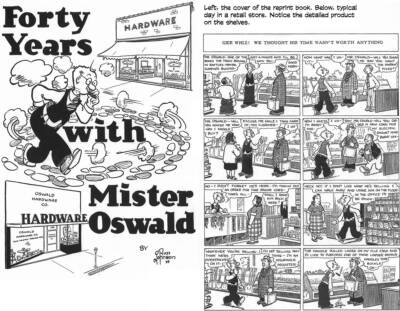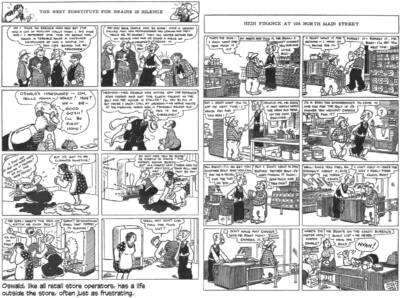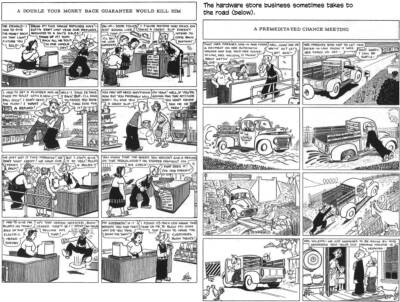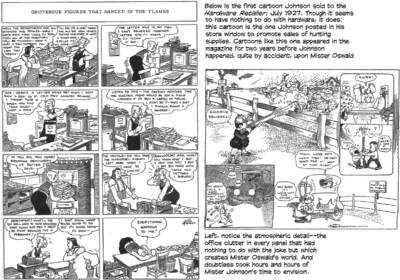Funnies Farrago encounters the longest-running comic strip: Mister Oswald.
IN 1968 WHEN A BOOK COLLECTION of Mister Oswald was published, Forty Years with Mister Oswald, almost no one knew about the eponymous full-page comic strip that appeared in the monthly trade journal, Hardware Retailer, except, of course, hardware store owners and operators. The journal had a circulation of about 30,000, so those subscribers knew Mister Oswald: they knew it was about a hardware store and its owner. But it’s highly likely that no one in comics fandom knew about the character or the comic strip. And in 1968, Mister Oswald had been published continually for 41 years.
It would continue for another 40 years, and its longevity was, at first, its most distinguishing characteristic among comics fans who’d never heard of it and wondered how that happened.
Perhaps the strip’s name — and its star player — contributed to its being so widely unknown.
Oswald is not an uplifting name. Russ Johnson, who created the character and named him Oswald, thought the name suggested a rather dumb person. Well, maybe not “dumb” exactly, but probably unsophisticated, a little frumpy, perhaps with a somewhat one-track mind.
Johnson gave Oswald a first name and middle initial — Oscar S. — but he regretted having done that. And when thinking or talking about the character, Johnson never called him “Oscar”; always, “Mister Oswald.”
He may not have liked the name, but he loved the character. Or, rather, he loved cartooning, and Mister Oswald enabled him to pursue his affair. And so he did — for six decades.
Starting in October 1927, Johnson drew Mister Oswald unassisted for 62 years, which prompted some aficionados to claim that the strip was the longest-running comic strip produced by a single individual in the history of the medium.
Unhappily, another comic strip has a claim to exactly the same record: Australian cartoonist Jim Russell has entered the Guinness Book of Records for drawing the same comic strip single-handedly without any assistance for a period of over 62 years. The strip was The Potts, which was called You and Me when Russell inherited it in 1940; he changed the name to Mr. and Mrs. Pott and then, in 1950, to The Potts, whereupon it promptly became a daily strip having thrived until then as a Sunday only strip.
Longevity records with comic strips are cluttered by variations and expectations. For instance, The Potts was a daily strip for over 50 years; Mister Oswald was a monthly effort, appearing in Sunday strip format (one-page) in Hardware Retailer, the magazine of the National Retail Hardware Association. In terms of sheer effort and persistent endurance, The Potts took much more of both than Mister Oswald. So what, exactly, do the cartoonists’ longevity records mean?
In terms of longevity, the top ten American-originated comic strips are as follows (all were drawn, at one time or another, by different cartoonists; unless otherwise noted, all the strips are still being published with new material):
The Katzenjammer Kids (started in 1897), a weekly strip, has run for 125 years
Gasoline Alley (1918), daily and Sunday; 103 years
Barney Google (1919), daily and Sunday; (later, Barney Google and Snuffy Smith); 102 years
Thimble Theater/Popeye (continuous since 1919); 102 years
Blondie (1930), daily and Sunday; 91 years
Dick Tracy (1930), daily and Sunday; 91 years
Alley Oop (continuous since 1932); 89 years
Annie (1924 as Little Orphan Annie), daily and Sunday, ending 2010; 86 years
Prince Valiant (1937), Sunday only; 84 years
Brenda Starr (1940), daily and Sunday, ending in January 2011; 71 years
— a tie with Beetle Bailey (1950), daily and Sunday; 71 years (68 by originator Mort Walker)
Such lists, with their qualifying and disqualifying footnotes, amusing and even edifying though they may be, have only a little to do with Mister Oswald: they put him/it and Russ Johnson in a longevity context, and rightfully so. Beyond that, nothing.
At the time of its debut, Mister Oswald was just another of several cartoons Johnson was doing. Johnson, who worked in the hardware store his father owned, had been contributing cartoons to Hardware Retailer for a couple years before Mister Oswald showed up. And Johnson was freelancing cartoons to other magazines at the same time.
But his most unusual production was a weekly cartoon that he posted in the window of the hardware store every Tuesday. It generated a following that was enthusiastic enough to congregate at the window on Tuesday mornings, awaiting the arrival of that week’s cartoon.
The cartoon might feature gags about items displayed in the window or it could be a caricature of the town loafer, leaning against a light pole with cobwebs stretching from his leg to the pole.
Much of my information about Johnson and Mister Oswald comes from an interview Rob Stolzer conducted with the cartoonist in 1995 when Johnson was 101 years old. Stolzer, a collector of original cartoon art and a dedicated aficionado of the medium, has recently launched a Russell Johnson/Mister Oswald website, https://misteroswald.com
“I’ve owned the domain name for a number of years,” Stolzer said, “and have just recently been given permission from the fine folks at Hardware Retailer to move forward with the website.”
Interested parties can subscribe to the site to be notified of each new posting.
RUSSELL JOHNSON WAS BORN ON A FARM at the middle of Illinois near what eventually became Gibson City on December 10, 1893; he died at the humbling age of 101, having retired from Mister Oswald in 1989.
Like most cartoonists, he began drawing at an early age.
“I remember sketching my dad and my brother playing checkers. I drew something and my dad laughed … The neighbors came in and he showed it to them, and they laughed.” Ever since, he said, “my one desire has been to draw a picture and make people laugh.”
Johnson went to college at Dixon College and Northern Illinois Normal School, a joint operation. Dixon was a business-oriented private college, while the Northern Illinois Normal School was a teacher training institution, said Rob Stolzer at his Mister Oswald website. “The schools ceased operation around the time Johnson graduated in 1915.”
Johnson promptly left the farm and went to the Big City, Chicago, where he found work at Montgomery Ward in the Exchange and Personnel Department. He also soon found an outlet for his passion for cartooning and started drawing cartoons for the store news.
When the United States entered the European War (later denominated World War I) in the spring of 1917, Johnson enlisted in the Navy. When discharged from the Navy at war’s end, Johnson returned to Chicago and his job at Montgomery Ward. He also started taking night classes in cartooning at the Chicago Academy of Fine Arts. His instructors were Carl Ed, who produced the comic strip Harold Teen, and Billy DeBeck, who did Barney Google.
“I’ll tell you, Billy DeBeck was a genius!” Johnson said to Stolzer. “That’s all there was to it. He could draw, and he had good ideas.”
DeBeck eschewed lecturing as a means of instruction: he strolled around the classroom, giving students individual instruction. DeBeck’s emphasis was putting action into the cartoons.
Johnson could remember only one of his classmates — Vaughn Shoemaker, who became the editorial cartoonist at the Chicago Daily News. At night school that winter, Johnson remembered, Shoemaker demonstrated that he hadn’t mastered perspective.
BY THIS TIME, JOHNSON’S FATHER had left farming and entered the hardware store business. Soon after World War I broke out, he sold the farm and bought a store in Anchor, Illinois, about 15 miles northwest of Gibson City.
In January 1921, Johnson moved the store to Gibson City. “He doubled his staff,” said his son, “ — he hired an employee.”
By September — eight months on the job — Johnson’s father was getting worn out by doing all the work single-handedly.
“He asked if I would take a six-month leave of absence from Montgomery Ward and come and help him,” Johnson remembered. “So I went down there and started to work for that store. I loved that old store. Boy, it was really great!
“I loved that hardware store right from the start. I enjoyed planning the window displays and departments. Everything. It was fun. I never even thought of returning to Montgomery Ward. Anyway, my leave of absence has probably been canceled by now,” he joked during a 1985 interview with Craig Yoe.
“I didn’t stop drawing cartoons,” he went on. “I made one for the window each week, to attract attention. If feasible, and where possible, with local background characters. It served its purpose. Every Tuesday, there were always several people waiting at the window to see what the next one would be.”
He continued cartooning beyond the walls (and window) of the store, too, mailing cartoons to various outlets. And he was sending out a little newspaper.
It was his aunt who got Mister Oswald into print.
His aunt was a school superintendent’s wife but she made spending money by writing articles for trade magazines. In 1925, she visited the Johnson hardware store in Gibson City. She saw Russ’s weekly cartoon in the window and wrote a story about it for the Hardware Retailer, headlining the story: ‘A Hardware Dealer Advertising with Cartoons.’
In Forty Years, Johnson quotes “the exact words” of Rivers Peterson, who was editor at the time: “I paid her for the story, threw it in the waste basket and caught the first train [from Indianapolis, where the magazine was published,] to Gibson City, where I made arrangements for Russell Johnson to draw cartoons for the Hardware Retailer regularly.”
He wanted to see samples first, and Johnson happily supplied them. When Peterson approved, Johnson started submitting cartoons, ultimately filling two pages in every issue with cartoons.
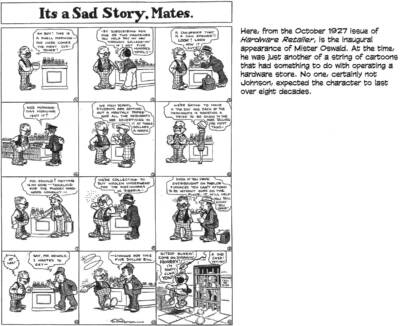 The one-page cartoon published in the October 1927 issue featured a hardware store owner, who, toward the end of the cartoon, is identified as Mister Oswald.
The one-page cartoon published in the October 1927 issue featured a hardware store owner, who, toward the end of the cartoon, is identified as Mister Oswald.
The editor wrote Johnson that the cartoon received such favorable comment that they would like him to continue the character. And so they did. On the character’s 60th anniversary, he was on the magazine’s cover. And Mister Oswald continued for yet another 21 years.
In appearance, Mister Oswald’s visage echoes that of Johnson’s father Fred P., who died in 1930, but, as author Max Collins observed, “Mister Oswald is clearly Johnson himself: a well-meaning but often frustrated merchant in a small town (Dippy Center), muddling through life as best he can. Though Mister Oswald is the strip’s constant fall guy, the butt of nearly every gag, he bounces back. If the strip has a moral, it’s to be found in the resiliency of this hardworking, good-hearted little man.”
Max Collins is the person who introduced Mister Oswald to the world of comics fandom.
I’ve been a fan of Mister Oswald ever since Collins, in a 1979 “guest review” in Don and Maggie Thompson’s Beautiful Balloons column in The Comics Buyer’s Guide, announced his discovery of a 286-page 1968 book collection of the strip, Forty Years with Mister Oswald.
The Thompsons were frankly awed by Johnson’s achievement, saying: “How often does someone discover a major comic artist whose name and work are unknown to comics collectors and historians but who has been working at his craft excellently for half a century?” Good question.
Collins’ review was an unabashed rave; he goes on:
“As in many strips, the central character (Oswald) is often overshadowed by the supporting characters — who tend to contrast Oswald’s Everyman normality with pure insanity. Since the audience of the strip was primarily hardware store owners, the customers often come across as unfeeling, slightly wacky opportunists; the salesmen who approach Oswald are manipulative connivers; Oswald’s employees are usually well-meaning but often bumbling (particularly the undersized Herman Hammers, hired during WW2 as a ‘temporary fill-in’ and still employed there today); and his relatives are leeches, with even his wife buying items from the dreaded enemy: the chain store.
“What is remarkable about all this,” Collins continues, “is that even the most unsympathetic characters are handled in a gentle, very human manner. Johnson — like Oswald — doesn’t hate anybody (not for long, anyway). Further, the hardware setting (and the very narrow audience the strip was aimed at) hinders Mister Oswald not whit; it’s as accessible as any great comic strip — and Mister Oswald is a great comic strip. If it’s going too far to call it a ‘classic,’ it’s fair to call it a ‘minor classic.’
“The artwork — and the humor — brings to mind such greats as H.T. Webster and Jimmy Hatlo. There is a similarity in the style of humor, as well. J.R. Williams also comes to mind — yet Johnson’s work doesn’t look like the work of anybody but Johnson. Echoes of contemporaries Billy DeBeck and Carl Ed (with whom Johnson studied at the Chicago Academy of Fine Arts) can be seen. Certainly, the work of underground cartoonists like R. Crumb and Jay Lynch (among others who strive for an ‘old-timey’ feel to their work) comes to mind.
“But Mister Oswald is a unique experience,” Collins finishes, “ — one any real fan of the comics will savor. Its depiction of small-town life is second only to Gasoline Alley; its humor is as fresh as Hagar or Beetle Bailey at their best. … The book is the story of 40 years in the life of a small-town America, and it evokes nostalgic memories.”
The book’s 286 pages are arranged in chronological order — the Great Depression coming before World War II — and divided into 41 chapters, each dealing with a different topic. Johnson introduces every chapter with a half-page of text about that chapter’s topic. Strung together, the introductory chapters make an autobiography of the cartoonist/hardware store operator.
The book’s publisher, Hardware Retailer, did not do much to promote sales of the book, Johnson said.
“I don’t know how many books they had printed,” he said. “As soon as it came out, they had me come over to Indianapolis and autograph 133 books to give away to all the top hardware men. They ran two or three ads in the magazine — $4.95 plus postage and handling. It had no information about what postage and handling would be, so how would you order the book? What would you do?
“I was told a lot of times by a lot of people that the only thing they read in the magazine was Mister Oswald, so a lot of people wanted to see it. I wanted to put down at the bottom of the cartoon, ‘The Oswald book is now ready’ because so many people kept asking me when there would be a book. But the managing editor wouldn’t let me do it. He said it would commercialize the cartoon.”
Commercialize the cartoon? The cartoon IS a commercial. What idiocy.
“They didn’t make much effort,” Johnson said. “After they got through giving some away, they sent me about 3,800 books. I put them in storage in Champaign [just down the road from Gibson City], and I autographed books in the hardware store here. I had no problem getting rid of all those books.”
The magazine’s editors may not have had any commercial instincts, but Johnson did.
He visited the Hardware Retailer headquarters in Indianapolis in 1962, and an editor told him that they get many requests from advertisers for the page next to Mister Oswald. And that made Johnson think:
“Gee whiz, if they get requests for advertisements on the page opposite the cartoon — why don’t they run cartoons on more pages?”
He and the editor agreed to experiment. Johnson lengthened the next Mister Oswald to two pages instead of just one. Instead of one adjacent page for advertisers, there were two. Advertisers were “tickled to death.” From 1962 on, Mister Oswald ran on two pages.
ONCE MISTER OSWALD STARTED appearing in the Hardware Retailer regularly, Johnson started getting requests for advertising cartoons from other hardware stores — and other businesses. He did two strips for Armstrong Cork Company — one for their retail stores and one for their wholesale outfit — a full page strip for Sporting Goods Journal, and another for Remington Arms.
The strips had casts of characters, Johnson explained. “In the strip that I did for Sporting Goods Journal, two guys ran a sporting goods store, and their names were Adam and Steve. For Armstrong Cork’s Wholesaler, I had Buster Bunk and the Boys; for the retail store, Sellem & Son.”
Before long, Johnson was spending more time at his drawing board in the back of the store than out front with customers. He finally sold the store in 1953 and devoted full time to cartooning.
“My dad died in 1930,” he said, “ — so I had to take it over. I not only had the hardware store, but my brother-in-law came down and started a shoe store. He pooped out on it and left me with the shoe store. So I had the hardware store, the shoe store, a bottled gas route and the strips! Sometimes I wondered how the Dickens I did all that!”
Before long, Johnson realized he was doing too much. He quit all the strips except Mister Oswald.
SOME OBSERVERS have called Johnson’s drawing style in Mister Oswald “big foot.” They arrive at this designation in the belief, apparently, that there are only two drawing styles: realistic at one end of the scale, and at the other, wholly unrealistic, “big foot.” But there are gradations between Realistic and Big Foot that these would-be critics seem unaware of. For them, Big Foot is the only alternative to Realistic. According to them, a cartoonist draws in one of these styles or the other; nothing else.
But there is plenty of “else.”
Imagine a scale with Big Foot at one end and Realistic at the other. Somewhere about in the middle is Caricatural, a style that exaggerates features in face and form. Right next to Caricatural is Cartoony.
Mister Oswald is rendered in a Cartoony style. This style is on the Realistic side of Caricatural. It offers lots of Realism, but not every character is realistically drawn. Most visual aspects of the strip are simplified imagery, not the complex of wrinkles in face and wardrobe that distinguishes Realistic.
Still, the characters don’t have big bulbous noses or huge feet. Not Big Foot, in other words. Cartoony is something in between. And it embraces a range of simplification from severe to suggestive. Severe Cartoony style reduces ordinary forms and anatomical shapes to simple geometric imagery. And it veers off in the direction of Big Foot — without quite getting there. Suggestive Cartoony style is severe but with hints of realism.
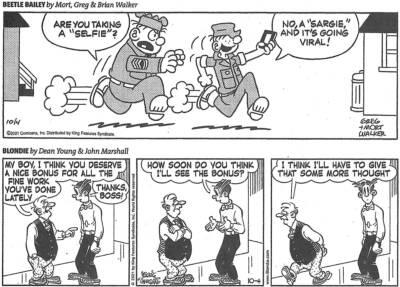 Beetle Bailey is drawn in a severe Cartoony style; ditto Hi and Lois and Dilbert and Pearls Before Swine. Blondie, on the other hand, is rendered in an suggestive Cartoony style. It simplifies imagery but leaves plenty behind — Dagwood’s shoes, for example; and the way Daisy, the family dog, is drawn.
Beetle Bailey is drawn in a severe Cartoony style; ditto Hi and Lois and Dilbert and Pearls Before Swine. Blondie, on the other hand, is rendered in an suggestive Cartoony style. It simplifies imagery but leaves plenty behind — Dagwood’s shoes, for example; and the way Daisy, the family dog, is drawn.
Mister Oswald is in the same group as Blondie — suggestive Cartoony. The chief clue distinguishing between severe and suggestive is wrinkles in clothing: suggestive has wrinkles; severe does not. Pickles and Luann and One Big Happy and Sally Forth are drawn in the same way.
Johnson finally sold the hardware store in 1953. He was 60 years old.
“And from then on,” Stolzer said, “you worked exclusively on Mister Oswald.”
“From then on, I enjoyed life,” Johnson said. “I lived the strip. I carried a little book around with me all the time. My wife complained about me looking at the book every once in a while, because I was living with all those people all the time. All those make-believe people, all those employees, I was living with them. When we would go to restaurants, they were at the table with us. I think I had some pretty good ideas.”
Johnson retired from the hardware business, but he had no inclination to retire from cartooning or from Mister Oswald. Even though a replacement had been lined up to take over Mister Oswald when he was through cartooning, Johnson kept going on the strip for another 36years.
Years later, at 95, Johnson was still cartooning. “As long as I can keep at it,” he said to Stolzer. In other words, he added, “I don’t have any plans to retire from cartooning.”
But that year, 1989, he did retire from Mister Oswald. Ironically, his last strip had been rejected by the editors at Hardware Retailer.
“After all the years I did the cartoon,” he said, “they finally turned one down.”
In the strip, the old lady goes into the hardware store to watch her tv serial because her own television set had gone on the blink. So she went in and sat down and watched it on the store’s demonstration model. Johnny Potts had a tv customer who came along, and he was bothering the old lady. Herman told Johnny that the old lady had AIDS. Johnny ran over to her and asked, “Is it true that you’ve got AIDS?” And she said, “Yes — one in each ear!”
Said Johnson: “The editors were afraid that people with AIDS would object to it.”
Johnson retired from Mister Oswald after 62 years, but Mister Oswald continued for another 20 years. The strip was taken over by Larry Day, an artist who worked for Leo Burnett, an advertising agency in Chicago. Day did illustrations for the Chicago Tribune’s Sunday magazine — watercolors for articles.
“He’s getting better,” Johnson allowed in his 1995 interview with Stolzer. “He’s been at it since 1989. He’s had it for six years. He’s getting a lot better each time. His handicap is that he didn’t have the retail experience. He never worked in retail stores, so his ideas were different than mine would be. But he’s doing better. As I say, he’s a wonderful artist, but he has a lot of work to do. His work looks a little like he’s doing it for the money. His work doesn’t look like he loves it like I did. My Mister Oswald cartoons, I think, show that my heart was in the hardware business.”
At the time of his interview with Stolzer, Johnson was working on a strip about retirees that he hoped to get syndicated. (It was never published.) He had tried before to get into newspapers with a strip. He concocted a couple and submitted them. Neither went anywhere, however.
“They always told me they weren’t funny enough,” Johnson told Stolzer. “I gave it an effort. I still remember one of the illustrators for one of the syndicates thought it was very good. He gave my name to the editor there and they asked for some samples. But they decided it wasn’t funny enough. My cartoons are, well…I had the talent for Gibson City.”
But Johnson was wandering off into self-deprecation. The strips he submitted weren’t intended to be funny: he was working up continuity storytelling strips.
“I think that was my mistake,” he said, “ — I wasn’t trying to be funny: I was trying to establish a story. I think that was one of the reasons my strip was turned down. If I’d spent a little more time trying to tell jokes, I’d have been better off. I was always trying to create a story.”
Johnson may have thought he could revive newspapers’ comic strips by contributing one of his own.
Growing up, Johnson had read the comics in the Chicago Tribune. He enjoyed The Katzenjammer Kits and Jimmy Hatlo’s They’ll Do It Every Time and Gaar Williams’ panel cartoons. He also admired Jay “Ding” Darling’s editorial cartoons.
He was still reading the comics in 1995, but he was disappointed that they’ve been reduced in size, which had a bad effect on the artform. When Stolzer asked him to name his favorite strip, he declined.
“I think they’ve deteriorated considerably because of the reduction in size,” Johnson said. “They all just tell jokes now, showing the heads talking to each other. There are no backgrounds, and they can’t help it. They’re too small. They’re putting too many strips on the page. They used to print a strip all the way across the page. Then they could put some detail in it. Those were good.”
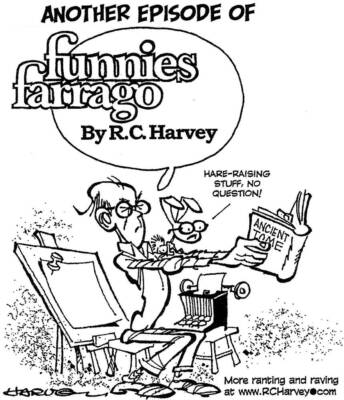 STOLZER SEES MISTER OSWALD as “a time-capsule of the 20th century American retail trade. It mirrors our country’s social history through the Great Depression, wars, and changing technologies.” And it was authoritative, produced by a man who worked and lived in the retail business.
STOLZER SEES MISTER OSWALD as “a time-capsule of the 20th century American retail trade. It mirrors our country’s social history through the Great Depression, wars, and changing technologies.” And it was authoritative, produced by a man who worked and lived in the retail business.
Stolzer added: “It was also drawn by a terrific cartoonist, one who had a great ear for dialogue and knew how to deliver a gag. Russ’ work featured excellent character development, strong line work, and a wonderfully delineated sense of place.”
- Funnies Farrago Celebrates a Half Century of Doonesbury - June 1, 2022
- Who Really Invented the Comic Character ‘Archie’? - May 7, 2022
- Dick Wright Returns - April 5, 2022

